"Ignignokt: Well well, I know that. I said that, but it's his nap time now.
Err: 'Cause he like, sleeps during the day.
Ignignokt: But at night he feeds.
Err: And it's always night on the Moon!
Ignignokt: Don't f*** with me, Err." -Aqua Teen Hunger Force, Moon Master
Ahh, the Moon. The brightest object in our night sky is familiar to all inhabitants of Earth, and during its full phase, easily outshines everything else in the night sky, combined.
Capable of casting strong shadows, and easily giving off a light that's bright enough to read by, the Full Moon brings a great deal of illumination to an otherwise dark night sky. In fact, not only is a sky with a Full Moon 40 times brighter than a moonless sky, but the Full Moon creates as much light pollution as some of the most impressive cities on Earth!
Even though the Sun, itself, is 400,000 times brighter than the Full Moon, the Full Moon is nearly 2,000 times brighter than the planet Venus, the next brightest thing in the night sky, and millions of times brighter than the dim stars you'll see on a moonless night.
The Full Moon as seen from Earth is even brighter than the Sun as seen from the farthest known Kuiper-Belt Object at aphelion.
But, as you've no doubt noticed, it's always the same side of the Moon that faces us. Even though there's a slight variation in the face of the Moon that's illuminated due to the orbital mechanics of the Sun-Earth-Moon system, we can always see nearly the same 50% of the Moon from Earth.
And if we can see them, then they can see us. From the point of view of someone on the side of the Moon that always faces Earth, they can see the Earth 100% of the time! Even when that portion of the Moon is experiencing "lunar night," the 14 days out of the month where the Sun doesn't shine on that portion of the Moon.
The far side of the Moon (often incorrectly called the dark side; it's just the side facing away from Earth) can never see the Earth. In fact, when orbiting spacecraft circling the Moon come from the far side back to the near side (the Earth-facing side), that's when an Earthrise occurs over the Moon.
From the middle longitudes on the Moon -- those areas that are illuminated from the first quarter phase to the last quarter phase -- the lunar "day" (when the Sun is out) corresponds to the smallest phases of the Earth. From these locations, when it's lunar "night," the Earth will always appear in at least a 50% phase.
While the Full Moon might be incredibly bright -- like I said, nearly 2,000 times brighter than Venus at its brightest -- the Full Earth as seen from the Moon is as bright as thirteen Full Moons, meaning that there will be plenty of light on the Moon when the Sun's not out, even if there's no heat.
You already know this, because when the Moon is just a thin crescent from Earth, you can still see the remainder of the Moon ever so faintly!
This is due to the reflected sunlight bouncing off of the Earth and striking the Moon; it's strong enough to illuminate the Moon as seen from Earth! We call this light Earthshine, and it's so bright that even a quarter-phased Earth (as seen from the Moon) is brighter than the Full Moon as seen from Earth!
So a huge area on the Moon -- nearly the entire side that's visible from Earth -- never experiences a night as dark as the least dark night on Earth!
Well, with one exception...
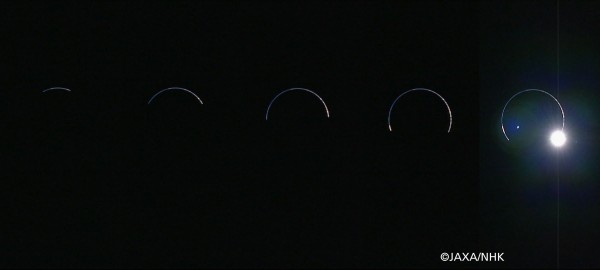
Image credit: JAXA / NHK, Kaguya / Selene, of a lunar eclipse as the Earth rises over the lunar limb.
During a lunar eclipse! So the Moon has its own version of night and day, but for the 50% of the Moon that faces us, night is a whole lot brighter than we've ever experienced!

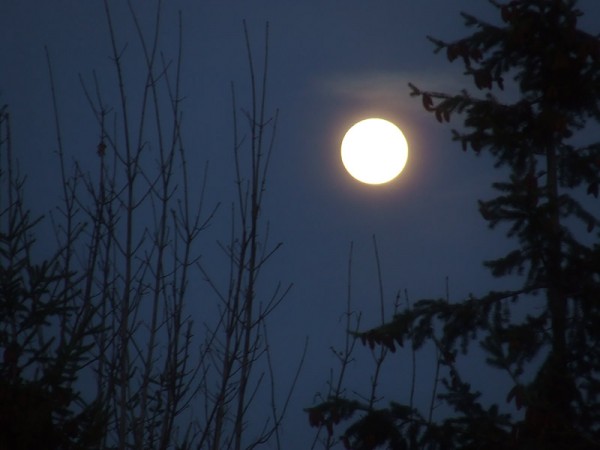
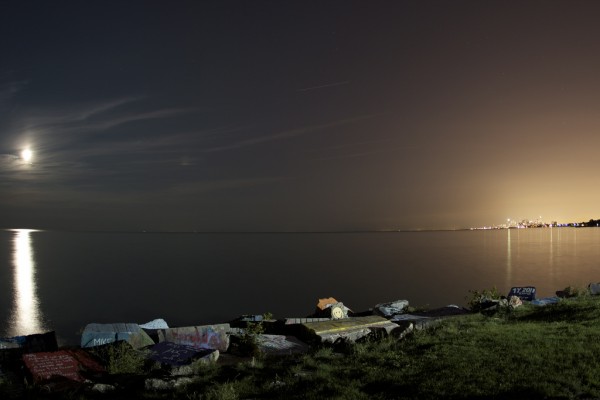
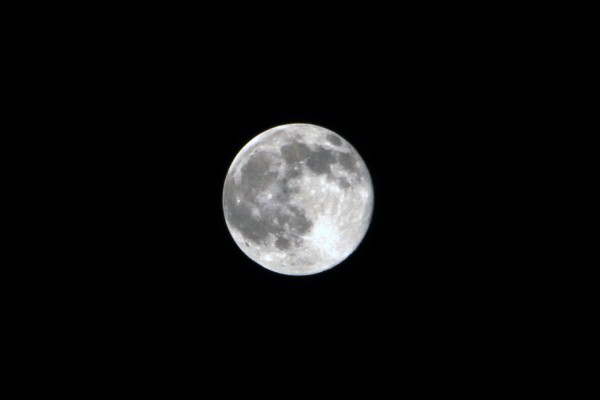
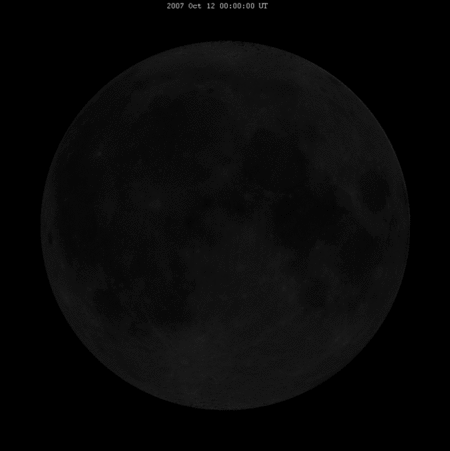
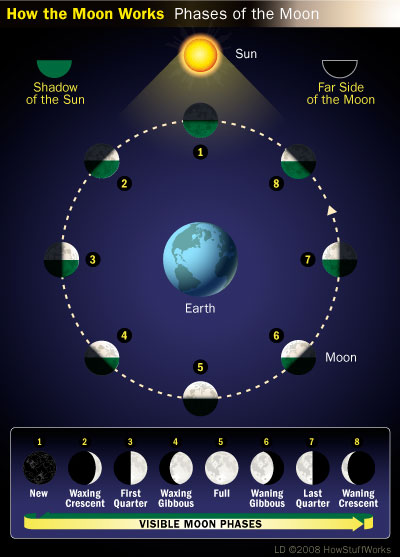
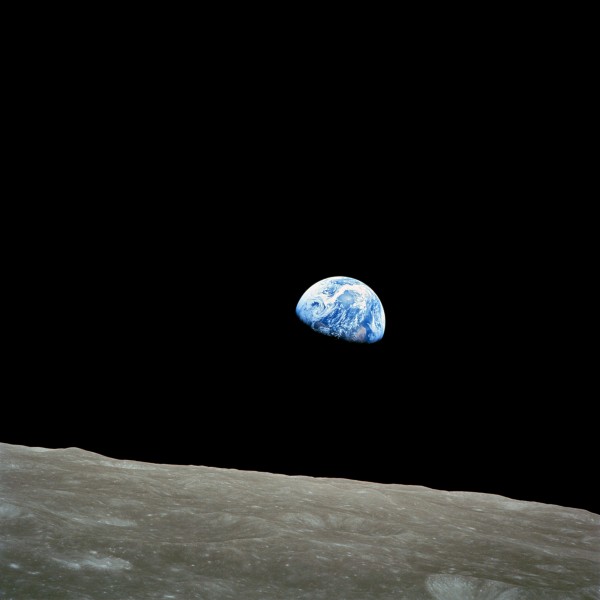
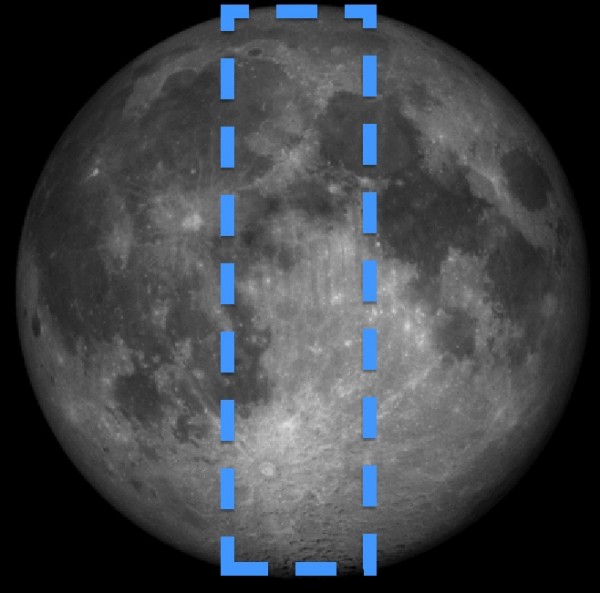
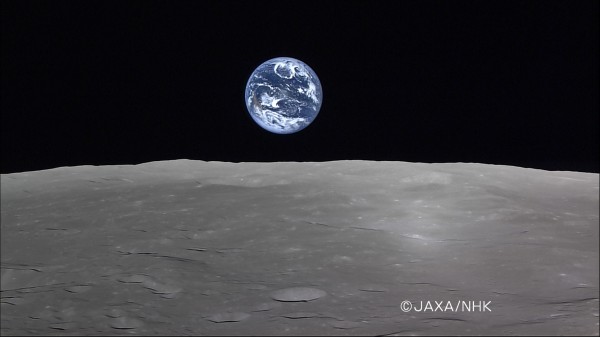
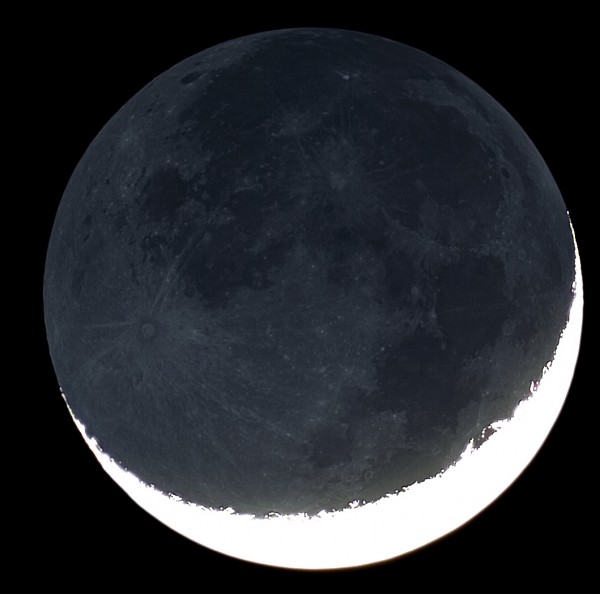
Wow, beautiful pictures came in to my mind! Any images available of this fantastic phenomenon?
Maybe a song? Earthshine by Rush: http://www.youtube.com/watch?v=_yz1l1dF6UA
"On certain nights, when the angles are right, and the moon is a slender crescent... its circle shows, in a ghostly glow, of earthly luminescence..."
Very nice explanations and pictures. A lot of moon facts that I didn't know.
But what caught my attention was the photograph of the Full Moon and Chicago.
Several years ago, I saw an exhibition of paintings and drawings by Edvard Munch. He did a series of paintings of the moon over water that seemed too stylized and unreal. Well that photograph shows that Munch's paintings captured the moon quite realistically. Maybe I just haven't been paying attention. Now I've got to look for the full moon over water to see what I've been missing and what Munch saw. Looking carefully at the photograph; it seems that the water needs to be still.
Searching online images of moon light over water; I see that most of the images are not like the photograph or like Munch's.
See Moon Light by Edvard Munch here:
http://www.wikipaintings.org/en/search/EDVARD%20MUNCH/2#supersized-sear…
Oh well, thanks Ethan.
Ah ha! The moon isn't always in our night sky!
Take THAT, scientists!!!
:-)
The dark side of the moon is "dark" in the same way as an age can be a "dark" age. Dark ages are called dark , because there's a lot less information (when compared to surrounding ages) to shed light on what life was like or things that happened during that period. This often corresponds to times where a civilization has collapsed, which leads to confusion about Dark Ages being "dark" as periods of misery, and barbarism... but that's not what it's about at all. You can have a dark age that corresponds to prosperous and peace times if major archives are lost or records were systematically purged later. For example, the loss of information from decay or obsolescence of media formats from the 20th century threatens a bit of a informational dark age, where old movies, TV show episodes, books, and computer records are being lost, which will make the era appear dimmer than the following digital age where storage is cheap, and everything is backed up forever, guaranteeing that eventually we'll be able to pick our leaders based on their teenage angst poetry.
In the same way the far side of the moon is "dark", observation of it has been possible for a few decades and is still not as intense as the near side.
So that will leave us with a lot of sleepless nights. Like a summer in the upper way up to the north that will never end.
So the question is: were is the "goldylock" zone on the moon were we humans can enjoy light/dark that we are used to?
I mean, were can we live without killing ourselfs?
http://www.biomedcentral.com/1471-244X/9/20/
Great article Ethan, but one mistake - a full earth is not 13 times brighter than a full moon - it is much brighter than that. The radius of the earth is 3.66 times bigger than the moon - giving an area 13.4 times bigger, BUT its albedo is also a lot bigger - about 3 times (depending on cloud cover). This is partly because the surface of the moon is actually rather like asphalt - very dark. The combination of the size and albedo difference gives a total brightness difference of about 13 x 3 = approx 40.
What do you mean it's never night on the Moon? Just as the Earth rotates away from the Sun so does the Moon. Why do you think the Moon has its phases? Why do you think the Moon doesn't always appear as a full Moon in the sky? As I've seen from the diagram, the Sun doesn't shine on 100% of the Moon's surface 100% of the time.
I am featured on the BBC website and anxious to bring my weblinks to everyone's attention. Simply visit Google and type in KELLER BBC or BBC KELLER, as you should see JEREMY KELLER BBC appear on the screen. You should also be able to find me on Google by searching for:
lunar mountaineering
lunar night earthlight
wreck of Luna 2
night half facing Saturn
craters resembling dividing cells
favour of flying cars
hexagon-shaped aircraft
motionized pictures
motionized paintings
I find it annoying that the Moon is the Earth's natural satellite and celestial neighbour yet I can't even go there. What's more the Moon is a familar sight in the sky and lights up the night sky. Well, having seen the Moon light in the earthly night I would now like to look the other way by seeing the Earth light in the lunar night. I believe the Moon also has its night phase. After all, why do you think it doesn't alwways appear full?
I would also like to see lunar mountaineering and the wreck of Luna 2. I think that mountaineering on the Moon would be easier than on Earth simply because the Moon has less gravity. But do people appreciate that? As for Luna 2, I believe that, according to the Instant Book of Outer Space, it left a Soviet pennant. According to the How and Why Wonder Book of Planets and Interplanetary Travel people have always wanted to conquer new worlds,lands and mountains. Some to find a precious commodity such as gold. Others for the romance of being the first to fly across an ocean, for example. Others might have wanted to explore the world's deepest cave.
Of course there seem to be other moons in our solar system. What about the Galilean moons of Jupiter, for example? To an observer on the Earth's moon the Earth might appear to shimmer like sapphire in the lunar night. So just think how spectacular Jupiter might appear in the night sky to an observer on one of the Galilean moons. To an observer on Titan Saturn might appear to resemble a spherical rainbow in the murky haze of the night sky over there. Furthermore, I believe Saturn has a moon with craters resembling dividing cells. How would it appear if an observer was standing directly between the two, where the two craters meet?
As well as my BBC link you should also be able to find me on Facebook by searching for FLYING CAR, MAVERICK, SAMSON or PLANE DRIVEN.
Having seen the Moonlight in the earthly night I would now like to see the Earthlight in the lunar night. Just think how spectacular it might appear. It would probably appear to shimmer like glowing sapphire.
As for the wreck of Luna 2, the wreck of the Titanic has apparently been located and photographed so how about similarly locating and photographing the wreck of Luna 2?
As well as my BBC link you should also be able to find me on Facebook by searching for CAR, ROBOY, CARAVELLA AEROSPACE or SOLAR SYSTEM.
I LIKE to see solar system.
https://www.facebook.com/jeremy.keller.1238
Jeremy Keller
Wednesday, 11 June 2014
Jeremy Keller
Jeremy Keller
I am very much in favour of flying cars.
https://www.facebook.com/TheMaverickFlyingCar?fref=ts
The Maverick Flying Car
How would the Earth appear in the lunar night?
I find it annoying that the Moon is the Earth's celestial neighbour and natural satellite, yet I can't even go there. What's more it seems to be a familiar sight in our sky.
http://www.bbc.co.uk/leicester/content/articles/2007/08/09/vn_marspleas…
How about NASA sending a rover to explore this gargantuan mountain?
Olympus Mons. (Biggest mountain in the Solar System!)
My surface.
How about the other vehicles performing as well in the Euro NCAP? Carbon fibre seems to be the answer.
http://www.youtube.com/watch?v=e2prYaASjqI
How would Saturn look in the night sky of Titan? Would it appear as a spherical rainbow in the murky haze?
Photo: Saturn’s Largest Moon Would Host Really, Really Weird Life “There’s a world I want to take you to, a world far different from our own, but one that may harbor life. If it does, it promises to be unlike anything we’ve ever seen before” -- Neil deGrasse Tyson in Cosmos: A Spacetime Odyssey Learn more: http://bit.ly/SgSroS
Another moon of Saturn's appears to have two conjoined craters resembling two dividing cells. How would it appear if an observer was standing where the two craters appear to meet?
I am also in favour of lunar mountaineering. I believe mountaineering on the Moon would be easier than on Earth due to there being less gravity.
I would also like to see the wreck of Luna 2 as it would really appear.. I believe this was the first man-made object to reach the lunar surface. Furthermore, I believe the wreck of the Titanic was eventually located and photographed.
http://www.action-transfers.com/html/pbipb_outerspace/pb_outerspace_c.s…
Having seen so many artist impressions I would like to see how such scenes would really appear.
Posted by Jeremy Keller at 10:35 No comments:
Home
Subscribe to: Posts (Atom)
Blog Archive
▼ 2014 (1) ▼ June (1) Jeremy Keller